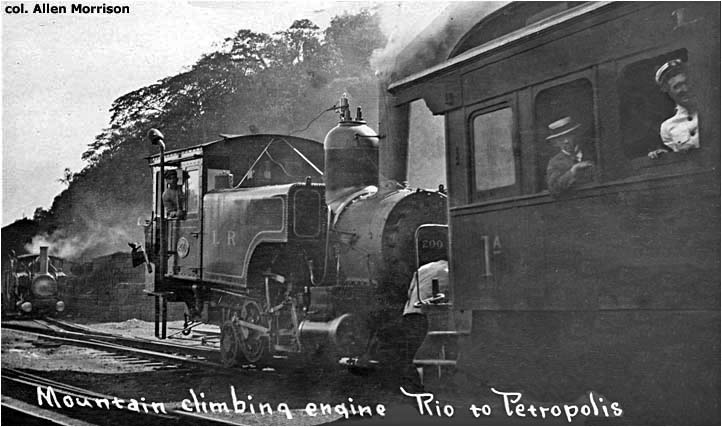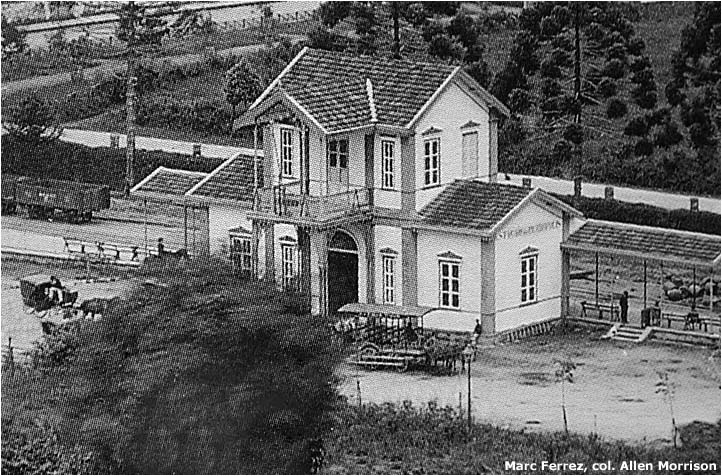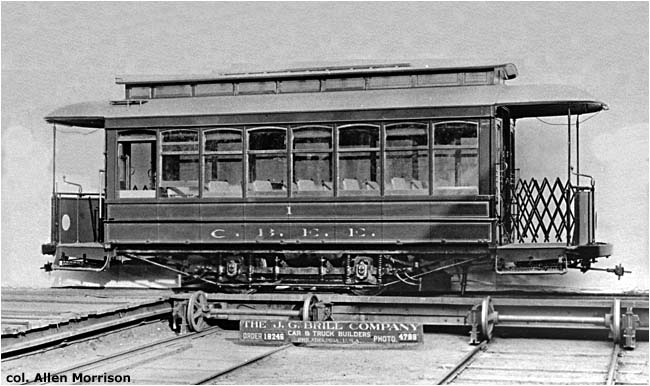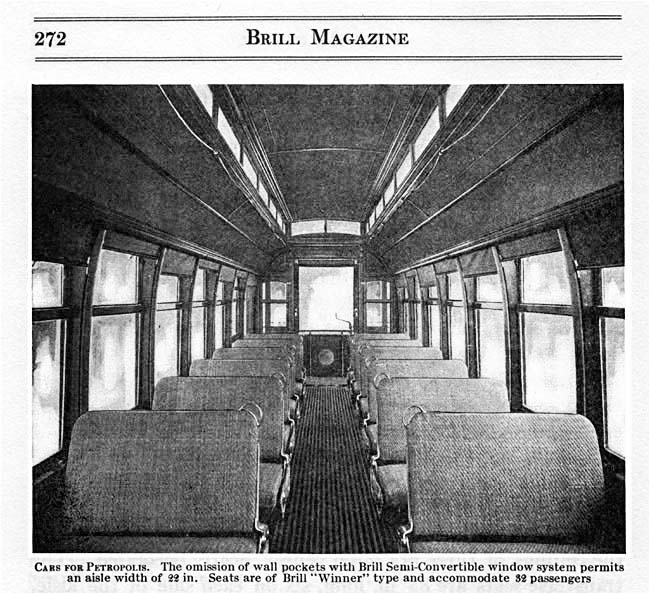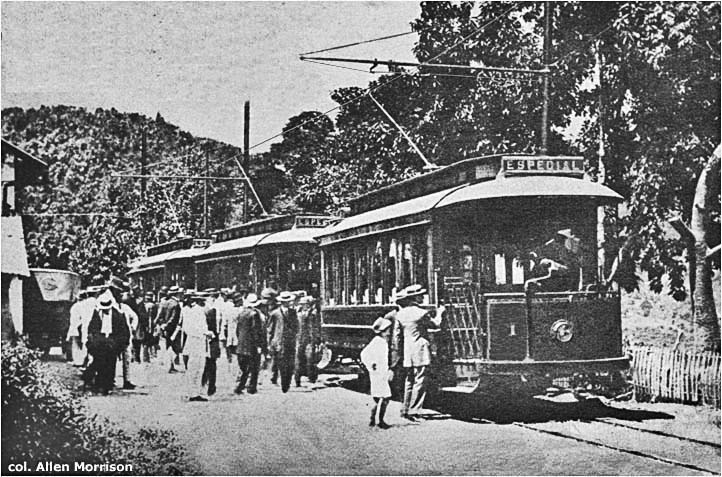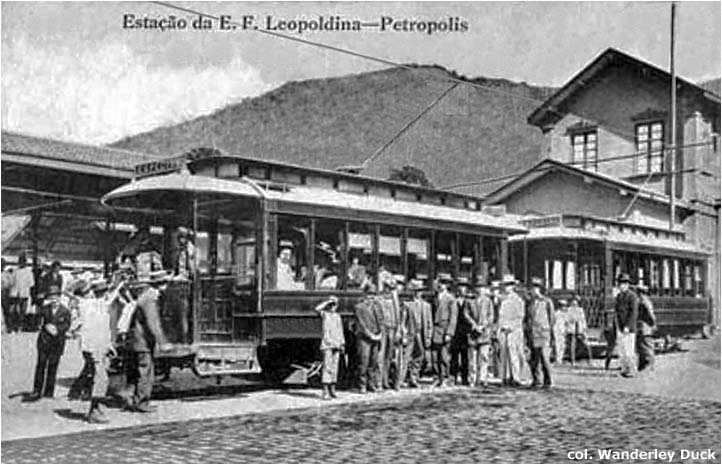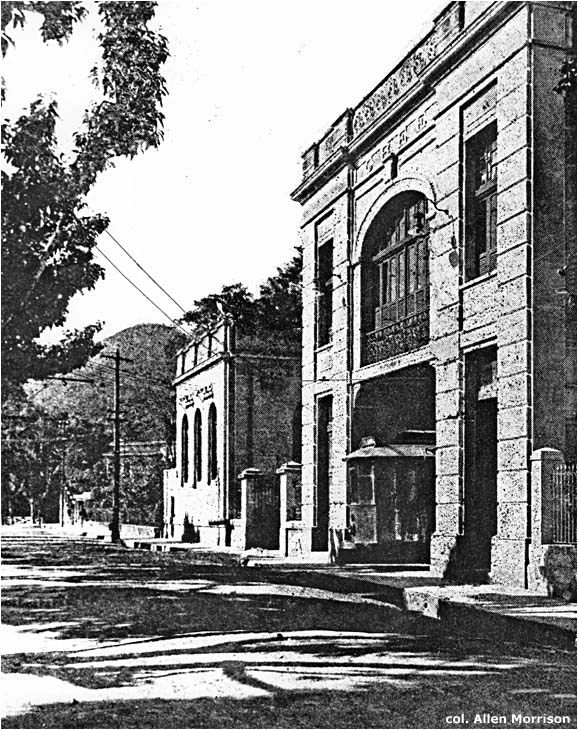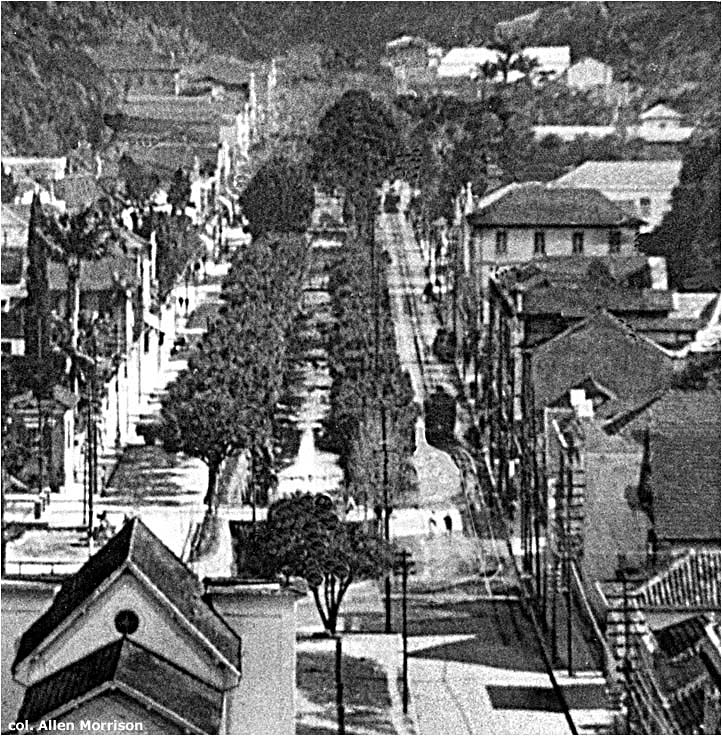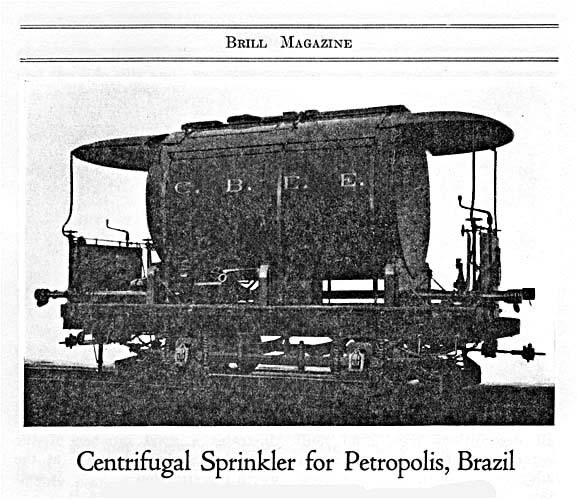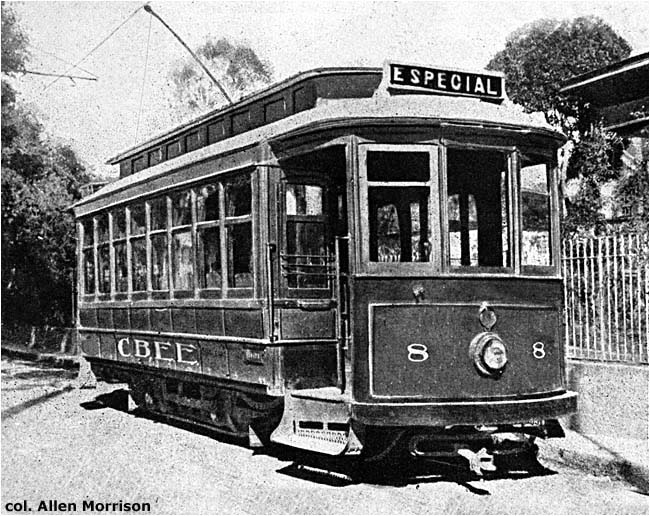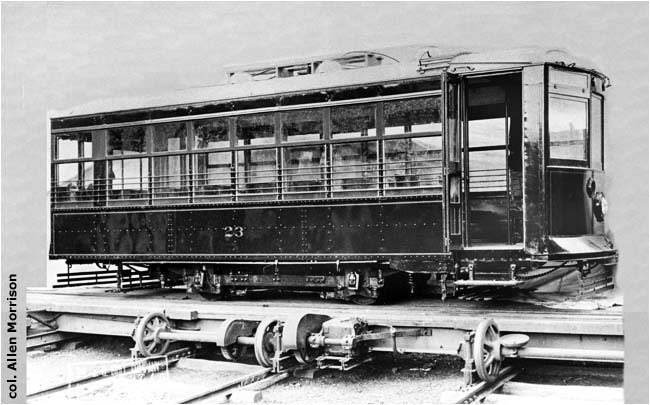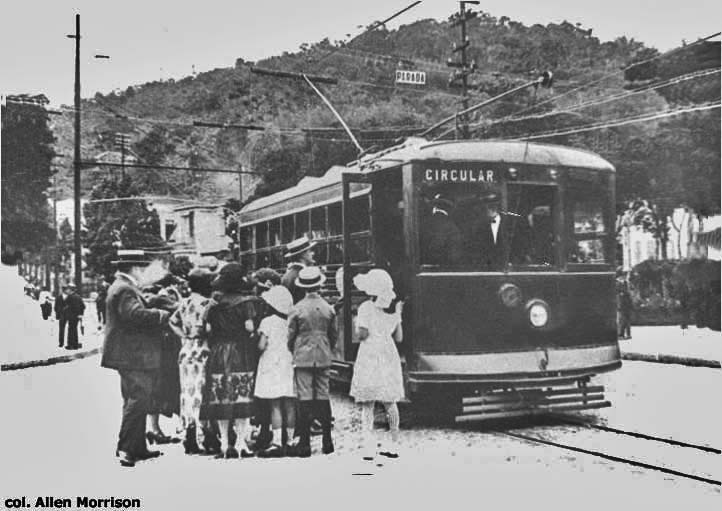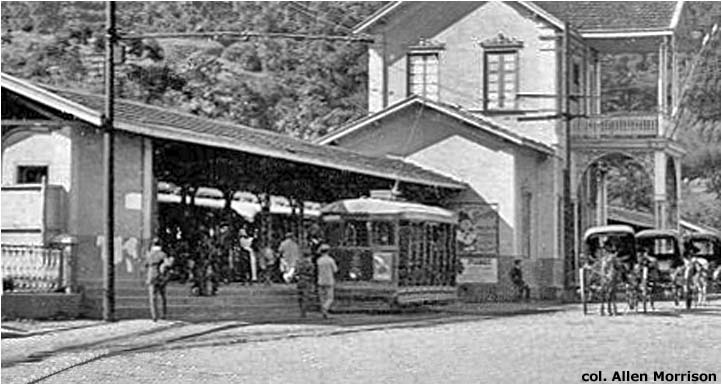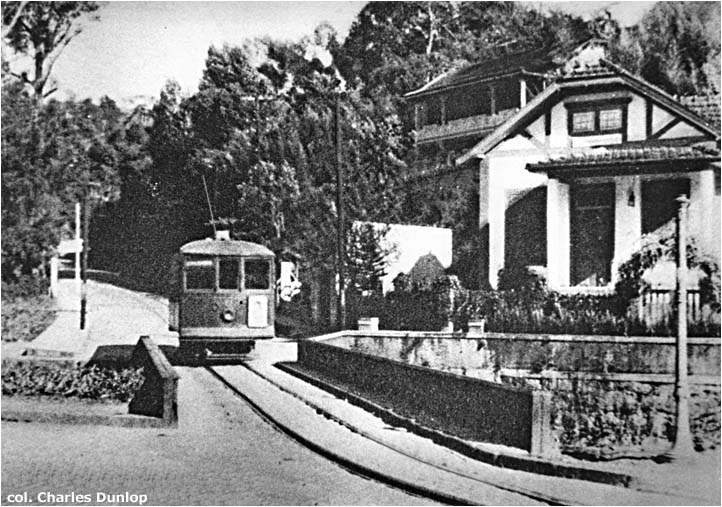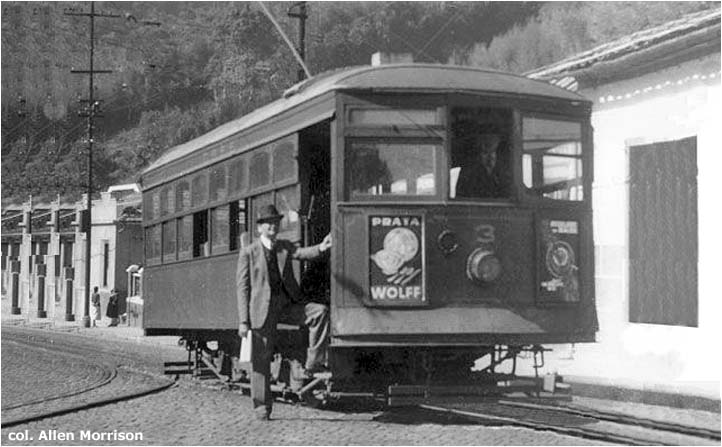PETRÓPOLIS
Rio de Janeiro state
BRAZIL
BY
Allen Morrison
Brazil's "Imperial City" is located at altitude 840 m / 2,756 ft in the mountains 60 km north of Rio de Janeiro. The spot was chosen by Emperor Dom Pedro I in 1830 as the place for a summer residence, a refuge from the heat (and malaria) of the capital. The new palace was completed in 1850 and the town grew up around it. The boat and carriage journey from Rio took 12+ hours and inspired the construction of Brazil's first railroad. The initial section of the line, from a dock on Guanabara Bay to Fragoso, was inaugurated in 1854 and trains reached Raiz da Serra, at the foot of the mountain, in 1856 [see area map]. Mule power up the twisting gravel road to Petrópolis had to suffice until the 6-km cog section of the line (South America's first cog railway) opened in 1883. The following postcard view shows a rack-and-pinion locomotive and coach some years later, when the line was operated by the Leopoldina Railway [col. AM]:
Despite several plans, Petrópolis never had a conventional horsedrawn tramway. However, in 1885 it purchased a dozen horsecars second-hand from Rio de Janeiro and ran them on wooden wheels. The photograph below is the only known illustration of one of these odd vehicles – waiting at Petrópolis railroad station [see city map]. The service continued until about 1900 [Gilberto Ferrez, Um Passeio à Petrópolis em companhia do fotógrafo Marc Ferrez: see BIBLIOGRAPHY]:
The city apparently had no public urban transport in the first decade of the 20th century. In March 1910 the local power supplier, Companhia Brasileira de Energia Elétrica, signed a contract to build an electric tramway. Construction began in 1911 and in March 1912 C.B.E.E. ordered eight 8-window closed trams from J. G. Brill Company in Philadelphia, U.S.A. Here is a Brill photograph of number 1 [col. AM]:
The following December it ordered four more. The illustration below shows the interior of one of the cars. The seat backs could be flipped so that the passengers could face either way [Brill Magazine (Philadelphia), 9/1912, p. 272]:
C.B.E.E. inaugurated a portion of the Cascatinha route on 13 December 1912 [see map]. Track gauge of the new electric tramway, as of the Leopoldina Railway, was one meter [col. AM]:
The Alto da Serra and Circular routes began operation in 1913 [see map]. The photograph below shows two cars at the railroad station on Rua Porciúncula – the same place shown in the second picture above [col. Wanderley Duck]:
Here is C.B.E.E.'s tram garage on Av. 7 de Abril [see map and Google Street View of the same two buildings in 2013]. Note tram at the door and company initials above the large window [col. AM]:
Petrópolis is surrounded by mountains and many of its thoroughfares, including its main street, straddle mountain streams. This fuzzy but interesting photograph shows a view west down Rua do Imperador from the corner of Rua Porciúncula, the street that leads to the railroad station [see map]. Tram tracks run on both sides of the stream down the center of Rua Porciúncula on the left, but only on the north side of the stream on Rua do Imperador. Trams ran in both directions on that single track – an arrangement that caused problems as traffic increased [col. AM]:
C.B.E.E. ordered this sprinkler car from J. G. Brill in June 1916 [Brill Magazine (Philadelphia), May 1917, p. 155]:
In 1917 C.B.E.E. began to enclose the platforms of its passenger cars. (The lettering on the side looks like it might have been added after the photograph was taken...) [col. AM]:
The remodeled car shown in the following postcard view is signed "ALTO DA SERRA" – but it seems to be running on the CICRULAR line in the residential north side of town [see map] [col. AM]:
In June 1920 C.B.E.E. ordered two "Birney"-type trams from J. G. Brill in Philadelphia. The fleet number of the other car is unknown, but the "23" implies that by 1920 the system had at least 23 cars. C.B.E.E. seems to have numbered all its vehicles in order of purchase, regardless of type [col. AM]:
C.B.E.E. ordered two more Birney cars in 1922, numbers unknown. The number on this car is, unfortunately, not visible [see map] [col. AM]:
The railroad station on Rua Porciúncula in the 1920s [see map]. Note horsedrawn "taxis" [col. AM]:
C.B.E.E. built a new line up a steep grade to the Rhenânia district in 1924 [see map]. This tram has come down Rua Gonçalves Dias and is about to cross the stream on Rua Coronel Veiga at the bottom of the hill [see Google Street View of the same place in 2013] [col. Charles Dunlop]:
In 1927 C.B.E.E. was absorbed by Empresas Elétricas Brasileiras, a Brazilian group controlled by the U.S. conglomerate Electric Bond & Share (a division of American & Foreign Power). The new owners inaugurated the city's first gasoline-powered bus lines. A new Rio-Petrópolis highway in 1928 flooded the city with buses, trucks and automobiles. Traffic congestion was compounded by the tramway system, whose vehicles often ran in both directions on a single track in the center of the road. As noted earlier, the problem was acute on the north side of Rua do Imperador, the city's main thoroughfare and an essential part of three tram routes [see map]. There was no way to improve the tramway system without major reconstruction, and that was unlikely during the Depression. The World Survey of Foreign Railways [see BIBLIOGRAPHY] reported that the Petrópolis tramway operated 21 motor cars (both passenger and work) and 7 trailer cars on 20 km of track in 1933. Tram revenues dwindled in the 1930s as the buses stole their passengers and provided faster service to the same destinations and beyond. The Cascatinha, Circular and Rhenânia tram routes closed in the mid-1930s and the city's last tram – number 3 (apparently renumbered) – made a final trip from Alto da Serra to the tram garage on Saturday night 15 July 1939 [see map]. The city's electric tramway era had come to an end less than three decades after it had begun. Luiz d'Escragnolle, the gentleman at the door in this photograph, had been present at the inauguration in 1912 [col. AM]:
|
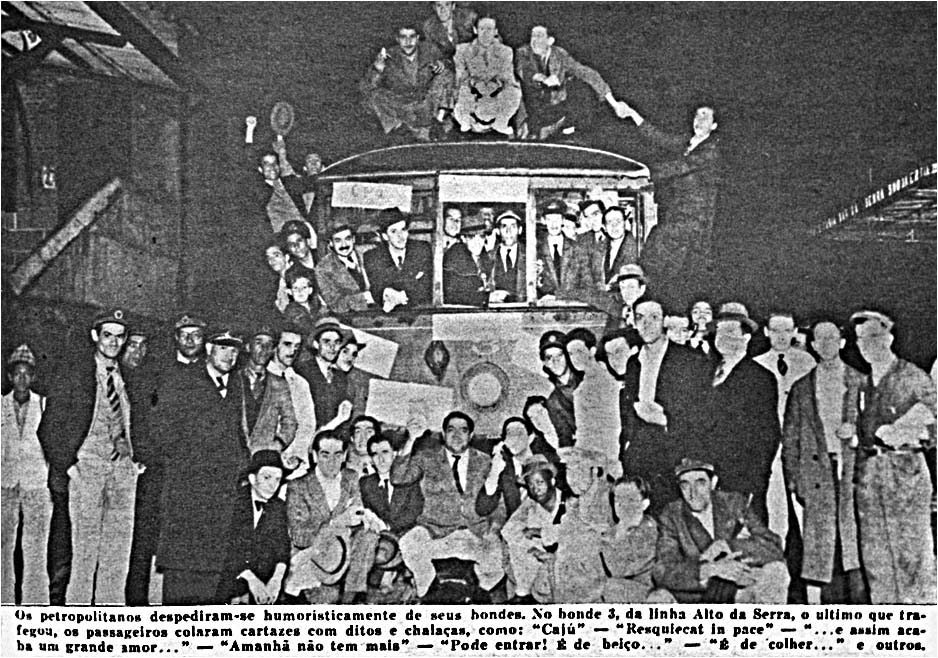
Finally, car 3 pulled into the tram garage on Av. 7 de Abril for the last time [see map]. It was a cruel, cold winter night in the Imperial City [col. AM]: |
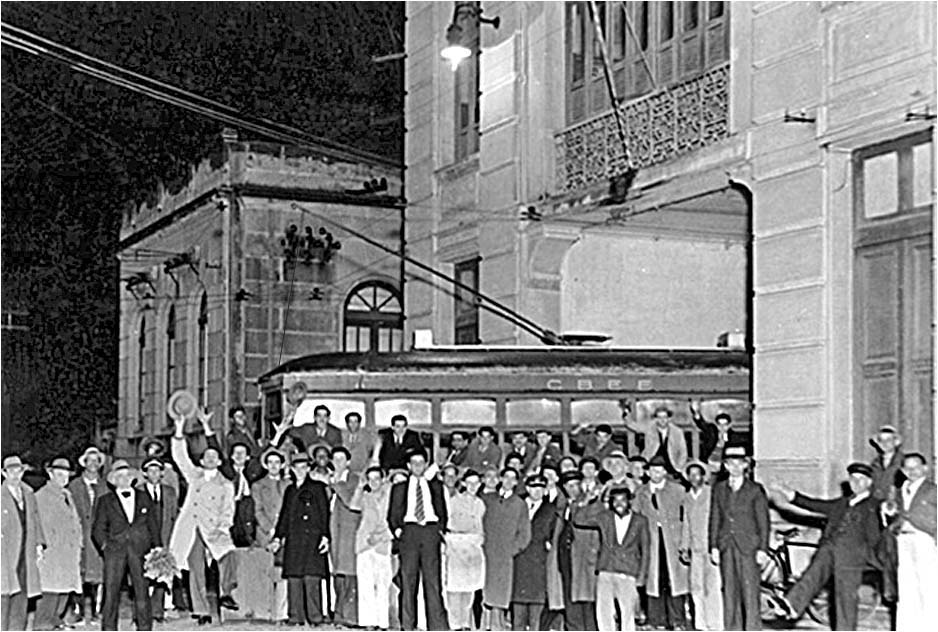
The Petrópolis tramway was one of the first electric tramways in Brazil to close. The electric lines in Piraju and Sacramento both closed in 1937 and Cachoeiro de Itapemirim closed in 1938. The electric tramway in nearby Além Paraíba closed 10 days after Petrópolis.
In 1942 Petrópolis sent 10 of its unused trams to the tramway operator in Campos, which rebuilt and ran them another 22 years. The Rio de Janeiro state government purchased 45 trolleybuses from the French company VETRA in 1951 and opened a trolleybus system in Niterói in 1953. Nine of the vehicles later went to Campos, which inaugurated a system in 1958. Petrópolis signed a contract in 1956 with the Swiss firm Kummler & Matter for the installation of trolleybus wiring [see news item], but apparently changed its mind: no evidence has been found that trolleybuses ever ran in Petrópolis. The Rio-Petrópolis cog line, which had been operated by the Leopoldina Railway since 1890, continued to carry passengers up the mountain for another 25 years. This postcard view shows a train on the "Deep Path" stone bridge just south of Petrópolis [see map]. Locomotives always pushed the cars up the hill [col. AM]: |
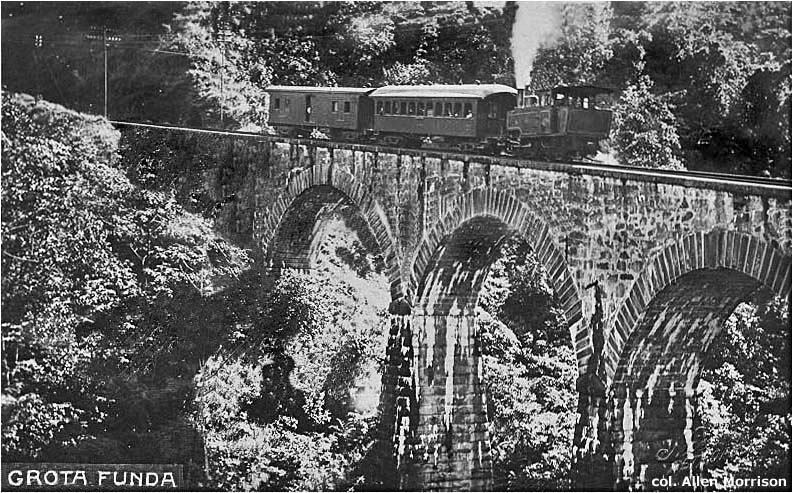
The following Google Street View shows the same bridge in 2013. The trains have been replaced by pedestrians and automobiles: |
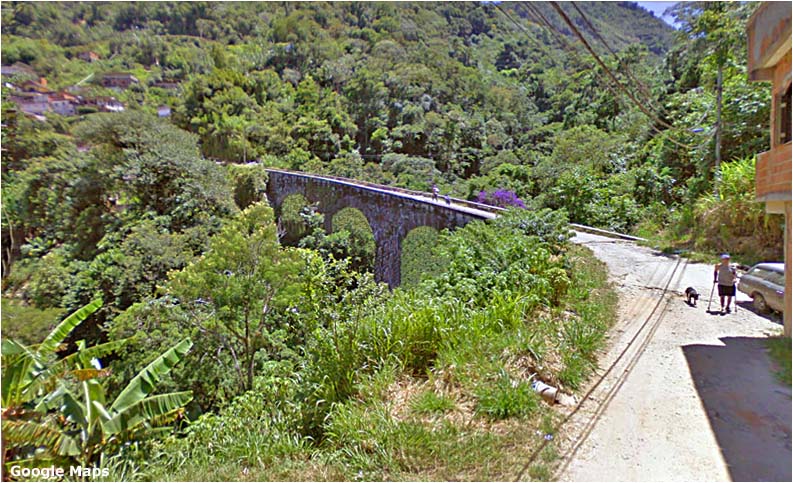
Another new highway up the mountain opened in 1960 and the Leopoldina ran its last train on 15 November 1964. South America's first cog railway was no more. Several sections of the railway path have been paved and become public roads. Suburban trains from Rio de Janeiro now run as far as Raiz de Serra, which has been renamed Inhomirim [see map].
BIBLIOGRAPHY Cyro Diocleciano Ribeiro Pessôa (Junior). Estudo Descriptivo das Estradas de Ferro do Brazil. Rio de Janeiro, 1886. The chapter on the Estrada de Ferro Príncipe do Gram Pará, pp. 257-263, provides excellent data on the Petrópolis railroad and its vehicles. A table on p. 260 describes the tunnels and bridges. Companhia Brazileira de Energia Electrica [sic]. General Report of the Works, Organization, Concessions and Franchises. London, 1910. Details of C.B.E.E. contract to build an electric tramway, pp. 211-213. "Equipment for New Brazilian Line" in Brill Magazine (Philadelphia), 9/1912, pp. 270-272. Article with two photographs of the first electric trams built for Petrópolis. "Bonds Electricos" in Tribuna de Petrópolis (Petrópolis), 14/12/1912, p. 1. Inauguration of the electric tramway. "Estado do Rio" in Brazil-Ferro-Carril (Rio de Janeiro), 15/6/1913, p. 232. Long article, with technical data, about inauguration of the Petrópolis tramway the previous December. "Centrifugal Sprinkler for Petropolis, Brazil" in Brill Magazine (Philadelphia), 5/1917, p. 155. Article and illustration. Prefeitura Municipal. Petrópolis. Petrópolis, 1928. Street map shows tram routes in detail. U.S. Bureau of Foreign & Domestic Commerce. World Survey of Foreign Railways. Washington, 1933. Rolling stock, track gauge and other data of the Petrópolis tramway. Edmundo Siqueira. Resumo Histórico de The Leopoldina Railway Co., Ltd. Rio de Janeiro, 1938. History of the British railroad. The "Estrada de Ferro Príncipe do Grão Pará" chapter, pp. 170-175, describes the route through Petrópolis, with details of the cog section. Guia Gutman 1937-1938. [Petrópolis], 1938. The map labeled "Parte Central de Petrópolis" provides detail for the rivers along the streets. Angelo Orazi. Rio de Janeiro and Environs ("Green Guide"). Rio de Janeiro, 1939. Itineraries of Petrópolis tram routes, p. 527. "O Primeiro e o Último Bonde de Petrópolis" in A Noite Ilustrada (Rio de Janeiro), 25/7/1939, pp. 31 & 34. Photos show both opening and closing of system. Incorrect opening date. [Author/publisher unknown] "Petrópolis" map, c.1945. Map at scale 1:60,750 is the only detailed map found that shows both the cog railway and the old stone road between Raiz da Serra and Petrópolis. Untitled news item in Der Stadtverkehr (Brackwede), 8-9/1956, p. 183. Notice of contract that Petrópolis signed with the Swiss firm Kummler & Matter for the construction of a 20 km trolleybus system. Richard P. Momsen, Jr. Routes Over The Serra Do Mar. Rio de Janeiro, 1964. History and description of the railroads and automobile roads that climbed the escarpment along the Brazilian coast. The Petrópolis roads are discussed on pp. 64-73, 88-89, 109-113 and 136-140. Victor Alves de Castro. Grande Rio Político e Rodoviário. Rio de Janeiro, 1980. Large map at scale 1:81,000 shows good detail of all highways between Rio and Petrópolis. H. L. Hoffenberg. Nineteenth-Century South America in Photographs. New York, 1982. Marc Ferrez photographs of the Rio-Petrópolis railroad, p. 72, and of carriage passengers resting along the first Rio-Petrópolis road, p. 84. Waldemar Corrêa Stiel. História do Transporte Urbano no Brasil. Brasília, 1984. The Petrópolis chapter on pp. 238-245 contains early history, six good tram pictures and a map. Charles J. Dunlop. Petrópolis Antigamente. Rio de Janeiro, 1985. "Os Primeiros Bondes de Petrópolis," pp. 81-3; "Os últimos Bondes," pp. 87-8. Thalita de Oliveira Casadei. Petrópolis. [Petrópolis?], 1991. The chapter on Charles Julius Dunlop. pp. 181-182, mentions Allen Morrison... Gilberto Ferrez. Um passeio a Petrópolis em companhia do fotógrafo Marc Ferrez. Rio de Janeiro 1993 (1948). Photograph of the "horse bus" on p. 59 of the 1993 reprint. Theodoro Gevert. Taking the train to Petropolis. Undated [c. 2004]. Nice personal account. Five illustrations, including a north-facing aerial view of Alto da Serra yards that includes the passenger station. Ralph Mennucci Giesbrecht. Estações Ferroviárias do Brasil. History, maps and photographs of Brazilian railroads and stations. The Petrópolis page provides interesting illustrations and valuable information about the Rio-Petrópolis railroad. Google Maps. An invaluable tool for identifying locations, determining current names, confirming long-gone tram routes, etc. The "Street View" feature is amazing, a sort of modern time machine...
In addition to the photographers and authors noted above, I would like to express my special gratitude to Senhores Paulo Modé, Ralph M. Giesbrecht, Antonio Pastori and Wanderley Duck for the information and assistance that they provided for the preparation of this page.
See my index of If you have comments, criticism or suggestions, This site was placed online on Copyright © 2013-2113 Allen Morrison |
